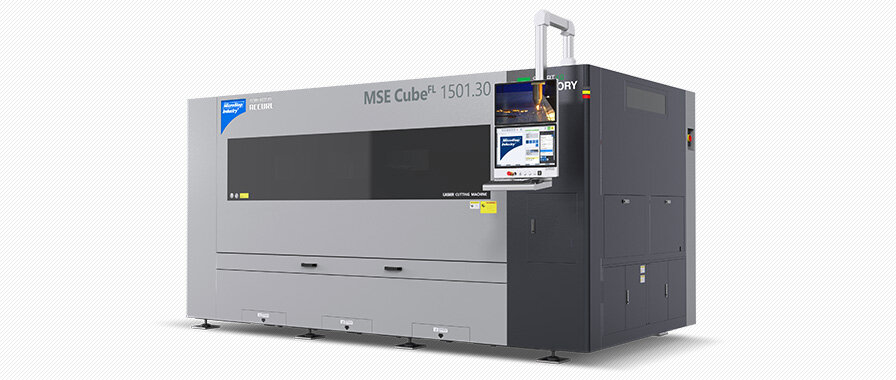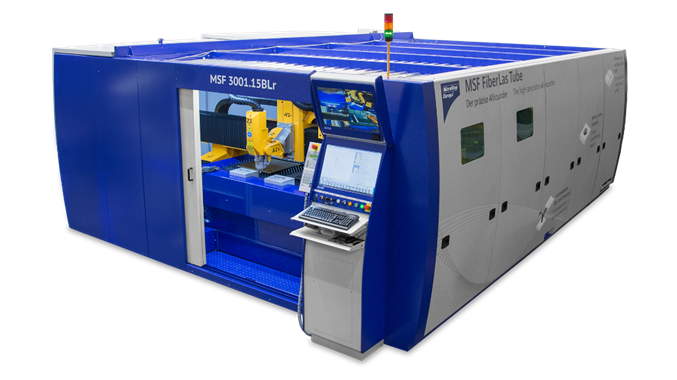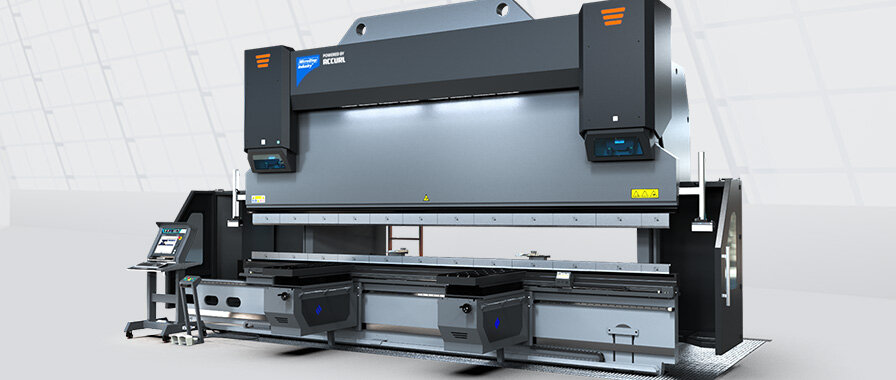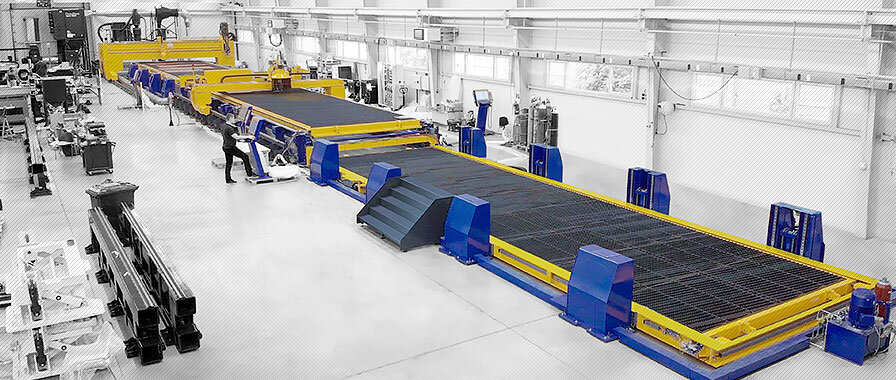
Reading time of the interview: 5 minutes
What possibilities does laser cutting technology offer?
Interview with our two laser experts Matthias Korn and Patrick Scheuner
Table of contents
- How do you become a laser expert?
- What fascinates you about the job in Service & Support?
- Which parameters influence the quality of the cut laser parts?
- What precision can be achieved with laser cutting machines from MicroStep?
- How important is appropriate training for operating a laser cutting machine?
- What safety aspects must be taken into account when operating a laser cutting machine?
- When is a laser cutting machine suitable and under what conditions is a different cutting technology recommended?
- How costly is the maintenance of a laser cutting machine?
- What service life can a company expect when purchasing a laser cutting machine?
- What options are there for automating the storage, loading and unloading of sheets?
- Is retrofitting possible if a company's requirements for the functions of a laser cutting machine change?
- What developments can be seen in the industry with regard to laser cutting machines?
You are part of the team of experts in laser cutting systems at MicroStep Europa. First question: How do you actually become a laser expert?
Matthias Korn: As far as I know, there is no direct vocational training in the field of laser machines. Of course, there were and still are physicists who have driven the development of lasers and there are now a few degree courses that deal with laser technology and the theoretical design and layout of lasers. I studied mechanical engineering and gained my first experience in the field of lasers during my practical semester and the subsequent diploma phase at a large German laser manufacturer, where I subsequently worked for many years in the application and research & development departments. In the field of mechanical engineering, a lot is still learning by doing. You have a basic knowledge thanks to your studies, but you have to acquire the rest.
Patrick Scheuner: I started out as a metalworker and became a master metalworker after my apprenticeship. In my company at the time, I operated a laser cutting system, among other things, and later also programmed it. With this prior knowledge, I was then able to delve deeper and deeper into the subject at MicroStep. Through exchanges with colleagues, with manufacturers and with many of my own tests, I gained experience and my understanding of the physical components grew. Every problem that you are allowed to solve takes you further.
What fascinates you about your job in Service & Support?
Matthias Korn: There is no foreseeable end to the development of laser technology. Since my studies, lasers and their application in industry have continued to develop. This makes the job extremely diverse and interesting in the long term.
Patrick Scheuner: Of course, this means that you are always faced with new tasks – whether in laser cutting or in another cutting technology. You are on site or in our own technology center and solve tasks, set up parameters and work closely with the operator so that the customer can ultimately work in the best possible way. Be it during commissioning, training or support. You work with customers from different industries, see a wide variety of applications, state-of-the-art technology and experience many small and large successes.

Let's take a more general look at laser cutting. Modern laser cutting systems are used for a wide variety of materials. What parameters influence the quality of the cut laser parts? Are there differences depending on the material?
Matthias Korn: A laser can of course be used to cut very different materials – there are different laser processes depending on the task. In principle, you first look at what the customer wants to cut and then select the type of laser with the right wavelength for the material group. Glass or wood, for example, cannot be cut with all laser types. The beam parameters and process parameters are then designed depending on the material group and the material thicknesses to be cut. The most important of these are the cutting speed, the focus position, the laser power and, of course, the cutting gas and the cutting gas pressure. In order to achieve the best possible results, the parameters must be adapted to the respective material or alloy.
What precision can be achieved with laser cutting machines from MicroStep?
Matthias Korn: A distinction must certainly be made here between the different types of laser cutting machines. Small precision cutting systems can achieve accuracies in the single-digit µm range, while the laser systems used in industrial production today have a higher accuracy, usually in the range of 0.1 mm and smaller, depending on the material thickness to be cut.
 Matthias Korn, Application Engineer Laser Technology at the MSF Pro laser cutting system in the CompetenceCenter South in Bad Wörishofen
Matthias Korn, Application Engineer Laser Technology at the MSF Pro laser cutting system in the CompetenceCenter South in Bad Wörishofen
I will be happy to answer your questions personally:
Research & Development Laser Technology
E-Mail: matthias.korn@microstep.com
How important is it to train your own staff to operate a laser cutting machine?
Patrick Scheuner: A laser machine is often one of the most expensive systems in operation. Of course, the operation of such a system is becoming more and more optimized and the control systems used are becoming increasingly intelligent, but the operator still plays a decisive role in the efficiency of such a system. Due to the wide variety of applications, the best possible results can only be achieved with the right knowledge. And what could be more expensive than the machine standing still or having to rework cuts because the operator lacks the necessary knowledge.
Matthias Korn: In addition, laser systems are highly complex systems that can only develop their full potential with the right training. This includes, for example, giving the operator an understanding of the interaction between the individual components of a laser system during training, as well as explaining the individual machine and laser parameters for the cutting process.
The topic of safety on the workplace is becoming increasingly important. What safety aspects must be taken into account when operating a laser cutting machine?
Matthias Korn: Beam protection is the most important part of a laser system. This is because the laser beam is the most dangerous component. There is also the danger posed by moving parts such as the shuttle table and the potential for injury from sharp-edged parts. At least the sharp edges are not foreign to the metalworker, even without a laser.
When is a laser cutting system suitable and under what conditions is a different cutting technology recommended?
Patrick Scheuner: The most suitable technology depends on various factors, such as the material thickness. We always recommend an individual consultation with our MicroStep experts to find the right technology for the respective cutting task. In general, the following can be said about the suitability of laser cutting systems:
Pro laser cutting systems
- High precision and quality when cutting different materials
- Cutting of small holes, acute angles and complex contours
- High processing speed in the thin sheet area enables the processing of large quantities
- Very good automation capability
- Extremely low heat input, virtually no distortion of the workpieces
- Very small kerf width
Contra laser cutting systems
- Not all materials can be cut with a laser
- Material grades and surface properties can influence the cutting result
- Unsuitable if no thermal impact on the material is permitted
- Relatively high start-up costs depending on the machine design
How time-consuming is the maintenance of a laser cutting machine?
Patrick Scheuner: The use of fiber lasers has significantly reduced maintenance times. When using a CO2 laser in a laser cutting system, the beam source is simply the most maintenance-intensive component. The fiber laser, on the other hand, is completely maintenance-free in this respect. This means that fiber laser cutting systems only require maintenance of the machine construction, axes, etc. The maintenance effort is similar to that of a CO2 laser. As with other types of cutting systems such as plasma, the amount of maintenance required simply depends on the size of the system, the degree of automation and the operating hours. We recommend maintenance every 2000 operating hours or at least once a year.
What service life can a company expect when purchasing a laser cutting machine? What factors does this depend on?
Matthias Korn: Of course, the machine equipment, care, maintenance and operating hours play a major role here. Experience shows that you can expect the machines to last between 10 and 15 years, although with good care and complete maintenance, you can produce for much longer.
Tip from our experts
Good care and complete maintenance significantly extend the service life of a laser cutting system. We therefore recommend maintenance every 2000 operating hours or at least once a year.
What options are there for automating the storage, loading and unloading of sheet metal?
Matthias Korn: There are different variants depending on the requirements:
- The simplest variant is an automatic shuttle table that enables loading and unloading from and into the laser cabin.
- This can be expanded to include a material handling system such as the MicroSteps MSLoad, which can be used for parallel loading and unloading and also automates the feeding and removal of the sheet metal to the shuttle table.
- In conjunction with a storage system such as the MSTower, virtually unmanned production can be achieved.
- There are also solutions for the variable processing of large-format sheets and systems that enable the automated material handling of pipes and profiles.
A company's requirements for the functions of a laser cutting system can change over the years. Is it possible to retrofit the machine in this case?
Patrick Scheuner: It is certainly possible to retrofit a machine, but depending on the requirements, it is often unprofitable. If you want to cut thicker materials or significantly increase the cutting speed, you may have to replace a lot more than just the laser source. This can even include reinforcing the shuttle table, new servomotors, etc. Here it is important to analyze the individual case in detail.
Finally, what developments can be seen in the industry with regard to laser cutting machines? What are users demanding and what are manufacturers pushing for?
Matthias Korn: The trend continues towards achieving higher speeds with higher laser power and cutting thicker sheets. As a result, an ever-increasing degree of automation is also required. After all, I don't want to lose the time I have gained with a faster laser when handling parts. In addition, advancing digitalization in the sense of Industry 4.0 is a groundbreaking aspect. Everything comes together in the quest for ever more efficient production methods.
 Dipl.-Ing. Matthias Korn is an application engineer for laser technology at MicroStep Europa GmbH. The technologist has been at the heart of the market for decades and is passionate about the further development of laser cutting technology. In various roles, he has played a key role in ensuring that MicroStep can now offer an impressive portfolio of solutions in the field of laser cutting technology.
Dipl.-Ing. Matthias Korn is an application engineer for laser technology at MicroStep Europa GmbH. The technologist has been at the heart of the market for decades and is passionate about the further development of laser cutting technology. In various roles, he has played a key role in ensuring that MicroStep can now offer an impressive portfolio of solutions in the field of laser cutting technology.
 Patrick Scheuner has been working in the Service & Support department at MicroStep Europa since 2016. The trained and qualified metalworker lives for preparing customers for their technology and helping them to get the most out of their system every day. He is one of the in-house specialists in laser cutting technology and takes care of the entire range of technical and customer-related tasks – from commissioning and training to demonstrations and consultations at exhibitions.
Patrick Scheuner has been working in the Service & Support department at MicroStep Europa since 2016. The trained and qualified metalworker lives for preparing customers for their technology and helping them to get the most out of their system every day. He is one of the in-house specialists in laser cutting technology and takes care of the entire range of technical and customer-related tasks – from commissioning and training to demonstrations and consultations at exhibitions.
Das könnte Sie auch interessieren:
 MSE SmartFL
MSE SmartFL



 MSE CubeFL
MSE CubeFL
 MSE TubeFL
MSE TubeFL






 MSF Compact
MSF Compact

 MSF Cut
MSF Cut
 MSF Pro
MSF Pro




 MSF Max
MSF Max
 MSF Pipe
MSF Pipe

 MasterCut Compact
MasterCut Compact
 MasterCut
MasterCut
 MG
MG

 DRM
DRM
 CombiCut
CombiCut
 DS
DS
 CPCut & PipeCut
CPCut & PipeCut
 ProfileCut
ProfileCut

 EasyCut
EasyCut

 WaterCut
WaterCut
 AquaCut
AquaCut

 SMART
SMART

 eB ULTRA
eB ULTRA
 EUROMASTER
EUROMASTER
 GENIUS
GENIUS


 MSLoad, MSTower, MSSort
MSLoad, MSTower, MSSort



 MSLoop
MSLoop
 MSFeed
MSFeed
 Digitalization
Digitalization
























